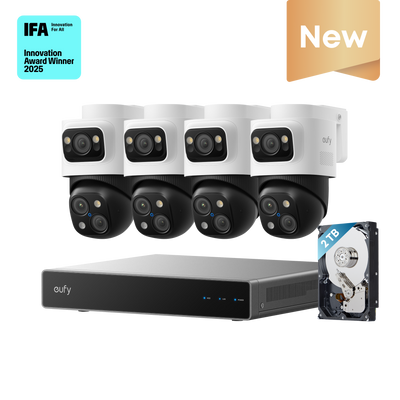If you’re serious about home security, a motion detection camera is one of the smartest upgrades you can make. But let’s be honest: motion alerts sound great until your phone starts pinging every time a car passes, or a tree moves.
That’s why choosing the best motion detection camera matters. You want one smart enough to tell the difference between a delivery driver and a wandering cat. One that catches what’s important and filters out the rest.
In this guide, we’ll walk you through what to look for, highlight the best motion detection cameras of 2025, and share expert tips to help you avoid buyer’s remorse. Let’s dive in.

What Is a Motion Detection Camera and Why You Might Need One?
A motion detection camera is a type of surveillance camera designed to start recording or alerting you only when it detects movement within its field of view. Using built-in sensors—typically passive‑infrared (PIR), radar, video analytics, or a blend of all three—the camera distinguishes between stillness and activity, making it a smart and efficient security tool.
Unlike traditional cameras that record continuously, motion detection cameras conserve storage and power by capturing footage only when something happens. This not only makes it easier to review key events but also reduces unnecessary data consumption, especially for cloud-based systems.
So why might you need one?
If you’re looking to enhance home or business security, motion detection cameras provide real-time alerts to your phone or email whenever motion is detected, helping you respond quickly to potential threats.
They’re also useful for monitoring deliveries, keeping an eye on pets or kids, or tracking activity around remote properties, all without watching hours of irrelevant footage.
Affordable and widely available, these cameras are a valuable upgrade for anyone seeking peace of mind and proactive surveillance without the hassle of manual monitoring.
Top Picks: Best Motion Detection Cameras in 2025
Below are some of the best motion detection security cameras available this year. Each offers reliable motion accuracy, clear video (day and night), and flexible storage or power options. Let’s take a closer look:
eufyCam S3 Pro 2-Cam Kit
The eufyCam S3 Pro 2-Cam Kit is built for serious outdoor coverage. It includes two 4K cameras paired with a HomeBase S380 hub, delivering crystal-clear footage both day and night thanks to MaxColor Night Vision™—and it doesn’t rely on spotlights to do it.
Dual radar and PIR sensors work together to cut false alarms by up to 99%, while the built-in BionicMind™ AI learns familiar faces over time to give you smarter, more relevant alerts.
Each camera charges itself using integrated SolarPlus 2.0 panels, and they’re built to handle tough conditions with IP67 weather resistance and operation down to -4°F. Storage is local, expandable from 16GB all the way up to 16TB, and you won’t need a subscription to access your footage. It also integrates seamlessly with HomeKit, Alexa, and Google Assistant.

Best for: Large homes looking for full-color, reliable outdoor coverage without monthly fees.
What’s good:
- 4K HDR video with true color night vision
- Large battery and self-charging via SolarPlus 2.0 panels give you year-long operation
- Dual radar + PIR motion detection with AI face recognition reduces false alerts significantly
- Expandable local storage (16GB to 16TB), no monthly fees
- Weatherproof (IP67), works from -4°F to 122°F
eufy Floodlight Camera E340
The eufy Floodlight Camera E340 combines powerful lighting and detailed surveillance in one sleek fixture. It uses two lenses: a 3K wide-angle and a 2K telephoto, which together give you an 8× hybrid zoom that can track someone across your property while still recording the full scene. The camera pans 360° and tilts 120°, with on-device AI tracking that follows people in real time.
{{component:"product", handle:"t8425121", sku:"T8425121"}}
The 2,000-lumen motion-activated LED panels light up dark corners and can be customized for brightness. Whether you’re using a microSD card (up to 128GB) or connecting it to the HomeBase S380, your footage stays local and subscription-free. The camera supports dual-band Wi-Fi 6 for a stable connection, even in busy networks.

Best for: Driveways, side yards, or any outdoor area that needs both lighting and security in one device.
What’s good:
- Dual-lens (3K wide + 2K zoom) with 8× hybrid zoom, capturing both the whole scene and details from up to 50 ft away
- Full 360° pan and auto AI tracking
- Built-in motion-activated floodlights (2,000 lumens) and siren
- Records locally to SD card or HomeBase
- Weather-resistant (IP65) with Wi-Fi 6 support
eufy 4G LTE Cam S330
The eufy 4G LTE Cam S330 is ideal for places where Wi-Fi just isn’t an option. Whether you’re monitoring a gate, barn, or off-grid property, this camera stays online using either 4G LTE (works with 3 major U.S. carriers) or Wi-Fi when available. It captures sharp 4K footage, even at night, thanks to its color night vision sensor and built-in 100-lumen spotlight.
{{component:"product", handle:"t86p2121", sku:"T86P2121"}}
The included solar panel keeps the 9,400mAh battery topped up—just two hours of sunlight can power a full day. You’ll also get 344° pan and 70° tilt, with AI object tracking that can follow people or vehicles and even capture license plates from up to 30 feet away. It ships with a 32GB microSD card and supports up to 128GB.

Best for: Rural, mobile, or remote locations without consistent Wi-Fi or power.
What’s good:
- 4G LTE/Wi-Fi hybrid connectivity with smart switching, supporting AT&T, T‑Mobile, and Verizon
- Solar panel included for continuous power
- 4K video with color night vision
- 344° pan and 70° tilt with auto AI person/vehicle tracking
- 32GB microSD included (expandable to 128GB)
eufy Indoor Cam S350
If you want the best camera for motion detection inside your home, the eufy Indoor Cam S350 is a solid choice. It combines two lenses—a 4K wide-angle and a 2K telephoto—so you get full-room and close-up views at the same time. With full 360° pan, tilt, and 8× hybrid zoom, the camera smoothly follows movement, whether it’s your pet, child, or unexpected guest.
{{component:"product", handle:"t8416121", sku:"T8416121"}}Smart AI detection can recognize people, pets, and even detect crying. Night vision is excellent too, using 2 infrared LEDs and dual f/1.6 aperture sensors to capture clear detail up to 32 feet in total darkness. It works over Wi-Fi 6 and offers local storage via microSD or HomeBase S380. Privacy mode and two-way audio make it ideal for daily use.

Best for: Parents or pet owners who want detailed indoor coverage with advanced tracking.
What’s good:
- Dual-lens 4K + 2K for split views
- 360° pan, tilt, 8× hybrid zoom
- Smart on-device AI detection (people, pets, crying)
- Clear night vision up to 32 ft
- Works with Alexa and Google Assistant
How to Choose the Right Motion Detection Security Camera for Your Needs?
Choosing the best camera for motion detection really depends on your space, your needs, and how much control you want over your footage. Here’s how to figure out what actually matters.
Look for smarter motion, not just more megapixels.
Cameras with dual sensors (like PIR and radar) or AI-based object detection are far more accurate than older models that trigger every time a leaf moves. The best ones can distinguish between people, vehicles, and animals—so you only get alerts when it matters.
Match the resolution to your viewing distance.
2K is a solid jump above 1080p for everyday facial detail. If you need zoom flexibility or license plate clarity from a distance, 4K is worth the bandwidth—just make sure your storage and network can keep up with the higher bitrate.
Don’t overlook night vision.
Basic infrared gives you grayscale footage in low light, but if you want to identify people or cars by color, go for a camera with true color night vision. Models that pair advanced sensors with controlled lighting strike the best balance between brightness and clarity.
Power and placement go hand in hand.
Wired cameras are great for consistent power and 24/7 recording. Battery-powered ones are easier to place where wiring’s not practical. If you’re setting up in a remote or hard-to-reach location, look for solar charging or even 4G LTE models that don’t need Wi-Fi at all. Also, consider climate IP ratings—especially if you’re mounting outside year-round.
Think through your storage setup.
Local storage—whether on a microSD card, a hub, or hard drive—means no subscription fees and more control over your data. Cloud storage is convenient and off-site, but it often comes with recurring costs. Hybrid setups (local + optional cloud backup) are a good middle ground.
Connectivity matters more than you think.
Dual-band Wi-Fi (2.4GHz + 5GHz) gives you better range and speed, and newer models that support Wi-Fi 6 handle busy home networks better. For off-grid areas, LTE connectivity can be a lifesaver.
Also check which smart home platforms the camera works with—Apple HomeKit, Google Assistant, or Alexa—and whether certain features require a paid plan.
Don’t skip on privacy and security.
Choose brands that offer two-factor authentication, clear encryption practices, and regular firmware updates. It’s not just about what the camera sees—it’s also about how that data is handled.
Expert Tips to Get the Most Out of Your Motion Camera
When setting up your camera, a few smart tweaks can make a huge difference in how well it works—and how helpful it is day to day. These expert tips will help you get cleaner footage, more relevant alerts, and better long-term performance.
- Plan your placement with purpose:Mount your camera about 7 to 9 feet off the ground, angled slightly down for facial detail. Overlapping views (especially at entry points) give you better coverage than relying on one wide-angle shot from far away.
- Fine-tune your motion zones early: Set up custom activity zones to avoid triggers from streets, tree branches, or shadows. You’ll get fewer false alerts and more meaningful notifications.
- Adjust sensitivity settings:If your camera is picking up too much motion (like shadows or insects), lower the sensitivity. For high-traffic areas, fine-tuning is key to avoid false alarms.
- Use the right resolution for your setup: 4K looks great, but only if your Wi-Fi and storage can support it. Otherwise, a well-placed 2K camera with efficient compression (like H.265) might actually give you a smoother, more reliable stream.
- Set up your night vision for success: Avoid aiming your camera directly at bright lights or reflective surfaces. Use adjustable floodlights or small spotlights to support color night vision, but keep them low enough to prevent overexposed footage or glare.
- Use AI filters with purpose: If your camera supports AI detection, only activate the filters you actually need—like person, vehicle, or package detection. The more streamlined your alerts, the less likely you’ll miss something important in a flood of noise.
- Choose your power source wisely: Wired connections are ideal for key entry points or areas with high traffic. Solar or battery-powered units are great for spots where you don’t want to run cable. Just make sure your solar panel gets enough direct sunlight to keep things charged consistently.
Conclusion
At the end of the day, the best motion detection camera is one that gives you real peace of mind—without bombarding you with useless alerts or missing what actually matters. The key is to focus on smart AI detection (people, pets, vehicles), clear night vision, and intuitive app controls. Now that you’ve seen what’s out there—and what to look for—you’re ready to make a smart, informed choice.
FAQs
What security camera has the best motion detection?
Cameras that combine radar and PIR sensors with onboard AI offer the best motion detection accuracy. The eufyCam S3 Pro, for example, uses dual sensors and BionicMind™ AI to reduce false alerts by up to 99% while recognizing familiar faces. Look for systems that let you set custom motion zones and adjust sensitivity, so you only get notified when it truly matters.
What security camera has the longest motion detection range?
The eufy Floodlight Cam E340 and eufyCam S3 Pro offer excellent long-range motion detection. The E340 uses dual lenses with 8× zoom and AI tracking to detect and follow motion up to 50 feet away, ideal for driveways or wide yards. The eufyCam S3 Pro combines radar and PIR sensors for highly accurate detection at distances up to 40 feet away, even in low light—making both great choices for large outdoor spaces.
What’s the best motion detection camera without a subscription?
The eufyCam S3 Pro stands out as a top choice with no monthly fees. It records in 4K, stores footage locally via the HomeBase S380, and offers dual-sensor motion detection with AI facial recognition—all without requiring cloud storage. eufy’s system is designed for users who want full functionality and security without recurring costs or losing control of their data.
Can motion detection cameras record all the time?
Yes, many motion detection cameras offer continuous recording options alongside motion-triggered recording. Continuous recording requires more storage, power, and bandwidth but ensures no moment is missed. You can choose based on your security priorities and storage capacity.















